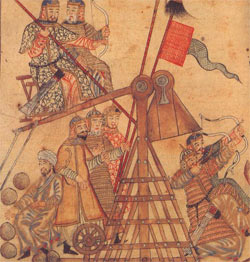In 1219 Genghis Khan, founder of the Mongol empire and the greatest of Asiatic conquerors, invited Chang Chun to visit him. Genghis' letter of invitation, dated 15 May 1219 (by present reckoning), has been preserved, one of the great curiosities of history. Here the formidable Mongol warrior appears as a meek disciple of wisdom, modest and simple, almost Socratic in his self-examination, alive to many of the deepest truths of life and government.
Chang Chun obeyed the summons and left his home in Shandong (February 1220) journeyed to Beijing. Learning that Genghis had gone further west upon fresh conquests, the sage stayed the winter there. In February 1221 Chang Chun started off again, traversing eastern Mongolia to the camp of Genghis' brother Ujughen, near Lake Bbr, or Buyur, in the upper Kherlen-Amur basin. From there he traveled south-westward up the Kherlen, crossing the Karakorum region in north-central Mongolia, and arrived at the Altai Mountains, probably passing near the present Uliastai. After traversing the Altai he visited Bishbalig, the modern Urumqi, and moved along the north side of the Tian Shan range to Lake Sairam, Almalik (or Kuija), and the rich valley of the Ili.

We then trace him to Balasagun and the Chu and across this river to Talas and the Tashkent region, and then over the Jaxartes (or Syr Dana) to Samarkand, where he halted for some months. Finally, through the Iron Gates of Termit, over the Oxus, and by way of Balkh and northern Afghanistan, Chang Chun reached Genghis' camp near the Hindu Kush. It was in Samarkand in the year 1221 where Chang Chun met with Muslim imams who viewed Chang Chun with disdain. He returned their contempt with the comment, "Why do you make the pilgrimage to Mecca? Do you not know that God is everywhere?"
Returning home he largely followed his outward route, with certain deviations, such as a visit to Kuku-khoto. He was back in Beijing by the end of January 1224. From the narrative of his expedition (the Hsi Yu Ki, written by his pupil and companion Li Chi Chang) we derive some of the most vivid pictures ever drawn of nature and man between the Great Wall of China and Kabul, between the Aral and Yellow Sea. Of particular interest are the sketches of the Mongols and the people of Samarkand and its vicinity, the account of the land and products of Samarkand in the Ili valley at or near Almalig-Kulja, and the description of various great mountain ranges, peaks and defiles, such as the Chinese Altay, the Tian Shan, Mt Bogdo-ola (?), and the Iron Gates of Termit. There is, moreover, a noteworthy reference to a land apparently identical with the uppermost valley of the Yenisei.
After his return, Chang Chun lived in Beijing until his death on 23 July 1227. By order of Genghis Khan some of the former imperial garden grounds were given to him for the foundation of a Daoist monastery, the White Cloud Monastery that exists to this day.
Authorship of Journey to the West (Xi You Ji) has sometimes been attributed to Chang Chun, but this is incorrect. The Xi You Ji was written by Wu Cheng'en. Such confusion may have arisen from its similarity to the title of Chang Chun's travel description, Qiu Chang Chun Xi You Ji.
en.wikipedia.org |





